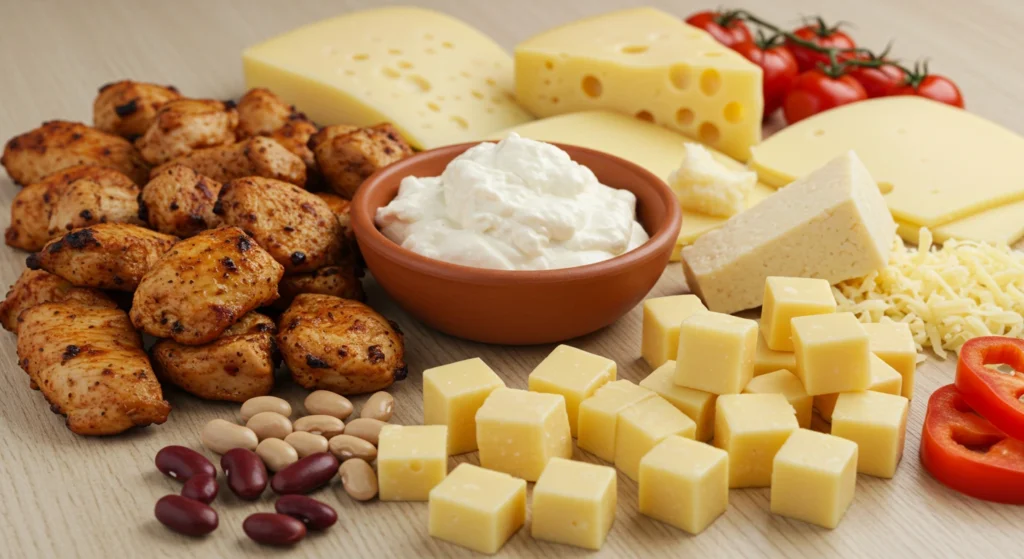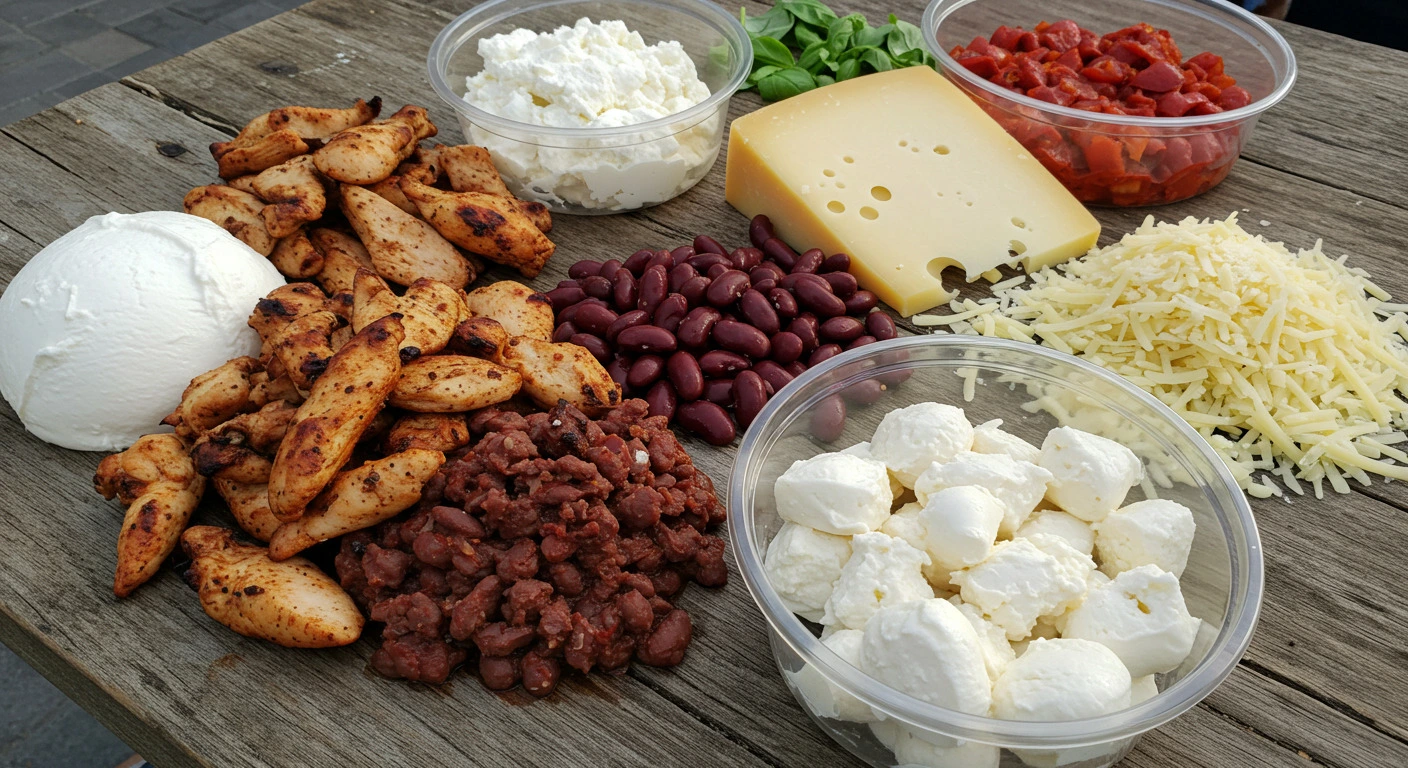Introduction :How to increase protein on a pizza
How to increase protein on a pizza is a key question for anyone aiming for a balanced meal. Pizza, often viewed as a comfort food, is a versatile canvas. You can use it to build an incredibly protein-rich and healthy meal. In this guide, we will discuss how to supercharge your pizza with protein, making it a healthier and more fulfilling choice.
Fundamentals of Protein-Rich Pizza
Understanding the role of protein is crucial. Protein is essential for muscle building, tissue repair, and overall health. Adding it to your pizza enhances its nutritional value. Consider various protein sources, such as meat, vegetables, and cheese, to tailor your pizza to your dietary needs.
Types of Protein
Protein can be sourced from animal and plant-based options. Animal proteins, such as chicken, turkey, and sausage, offer complete protein profiles. However, you can also add plant-based sources, such as tofu, beans, and lentils. These can also create incredibly healthy pizza choices.
Choosing Your Crust
The crust is the foundation. Opt for whole-wheat or cauliflower crusts for added fiber and nutrients. You can even find protein-enriched crusts in some stores, adding another layer of protein.
Selecting Your Sauce
Choose a sauce that enhances your pizza. Tomato-based sauces are generally healthy. However, be mindful of added sugars. Consider adding a creamy sauce like a ricotta or pesto for more flavor and protein.
The Importance of Cheese
Cheese, when chosen wisely, contributes to the protein content. Opt for low-fat or part-skim cheese varieties to balance the nutritional content.
Ways to Increase Protein on a Pizza
Adding protein requires a strategic approach. This ensures that your pizza becomes a balanced meal.
Meat Toppings
Adding meat is the most straightforward way to boost protein levels. Consider lean meats such as grilled chicken, turkey, or lean ground beef.
Image Placeholder: “Image: Pizza with various meat toppings”
Furthermore, you can add pepperoni, sausage, or bacon, but always do so in moderation. These are higher in fat.
Plant-Based Options
Plant-based options are a great alternative or addition. Incorporate tofu, beans, lentils, and tempeh. These offer valuable protein without the saturated fat found in some meats.
Dairy Products
Dairy can be a significant source of protein. Ricotta cheese is high in protein. Mozzarella cheese is a popular choice that also provides protein. These can increase the overall nutritional value.
Protein-Packed Veggies
Vegetables can also provide protein. Mushrooms, spinach, and broccoli contribute some protein content, along with valuable vitamins and fiber.
Eggs as a Topping
Adding eggs to your pizza can significantly increase protein content. Scramble them and distribute across the pizza or use them as a base. This is a great way to add protein.
5 Steps to Maximizing Protein on a Pizza
The steps provided below will guide you in creating an amazing protein-rich pizza.
Step 1: Crust Selection
Choose a crust that supports your goals. Whole-wheat or high-protein crusts are ideal. If you want a low-carb option, cauliflower crust is a great alternative. It sets the stage for a healthy pizza.
Step 2: Sauce and Cheese Selection
Select a tomato-based sauce without added sugars. Choose low-fat or part-skim mozzarella. Adding a dollop of ricotta cheese can significantly boost protein.
Step 3: Protein Boost
Add your desired protein. Chicken, turkey, or plant-based options like tofu or beans are all great. Be generous with your toppings.
Step 4: Vegetable Additions
Enhance your pizza with protein-rich vegetables. Spinach, mushrooms, and broccoli are all excellent choices. These will improve the nutritional profile.
Step 5: Cooking
Cook your pizza according to the instructions, usually by baking it in an oven. This ensures that all toppings are properly heated and cooked.
Considering the Pizza’s Nutritional Profile
When you add protein to pizza, it’s vital to consider the overall nutritional balance. This includes the amount of carbohydrates, fats, and other nutrients.
Carbohydrates
The carbohydrates in pizza primarily come from the crust and sauce. Choose a crust that is lower in carbs or one that provides fiber. Be mindful of the sugar content in the sauce.
Fats
Fats are present in cheese, meat toppings, and some sauces. Choose lean meats and cheeses. You can also be careful with the amount of cheese that you use.
Other Nutrients
Consider the vitamins and minerals that your pizza provides. Vegetables add essential nutrients, such as Vitamin C and potassium. Choose ingredients that enhance the overall nutrient density of your pizza.
Addressing Potential Downsides
While protein-rich pizza is a great choice, there are some things you should consider.
Sodium Content
Some toppings, like pepperoni and sausage, can be high in sodium. Moderate your usage. Be careful when choosing processed meats.
Saturated Fat
Some meats and cheeses are high in saturated fat. Choose lean options or use in moderation. Be mindful of the saturated fat intake.
Calorie Density
Adding protein can increase the calorie density of your pizza. Be mindful of portion sizes to maintain your calorie intake. Make it a good option for healthy eating.
Exploring Protein-Rich Pizza Variations
Beyond basic toppings, there are countless variations you can try to make your pizza even more protein-packed and exciting.
Exotic Protein Sources
Venture beyond the usual choices and experiment with less common protein sources. Consider adding things such as:
- Seafood: Shrimp, scallops, or even grilled fish can bring a new flavor and significant protein.
- Quinoa: As a side or combined with other toppings. It adds a nutty flavor and is a complete protein.
- Edamame: Steamed edamame adds a pop of green and is a great source of plant protein.
Ethnic Inspired Pizzas
Draw inspiration from different cuisines.
- Mediterranean Pizza: Use a base of hummus, topped with grilled chicken or chickpeas, feta cheese, olives, and sun-dried tomatoes.
- Mexican Pizza: Utilize a black bean base and add seasoned ground beef, or tofu, topped with shredded cheese and jalapenos.
- Thai Pizza: Use a peanut sauce base, with grilled chicken, tofu, and bean sprouts.
Creative Crust Options
The crust itself can provide a protein boost.
- Protein-Enriched Crusts: These are increasingly available in stores. They are often made with added protein powders.
- Cauliflower Crusts: These can be made with added protein. They provide both protein and fiber.
- Use Whole-Wheat or Spelt Dough: These are a great alternative. They enhance the protein content compared to traditional white flour.
The Science of Protein Absorption and Pizza
Understanding how our bodies use protein helps optimize your pizza for maximum benefit.
Protein and Muscle Growth
Protein is crucial for building and repairing muscle tissues. It does this through a process called protein synthesis. When consumed with exercise, the body uses protein to create new muscle.
Timing Protein Intake
Consuming protein after exercise can enhance muscle recovery and growth. You can time your pizza meal accordingly, especially after a workout. This can help promote greater results.
Complementary Proteins
Combine different protein sources to ensure you’re getting all essential amino acids. Combining plant-based proteins like beans and tofu can help create a complete protein profile.
Protein’s Role in Satiety
Protein helps you feel full. When consumed on a pizza, it can help keep hunger at bay. This reduces overeating.
Cooking Techniques to Preserve Protein Quality
The way you cook your protein can affect its nutritional value.
Gentle Cooking Methods
Avoid high heat cooking methods. These can break down the protein structure.
Baking vs. Frying
Baking is usually a healthier option than frying. It reduces the addition of unhealthy fats.
Marinating
Marinating your protein enhances flavor. It can also tenderize it, making it easier to digest.
Temperature Control
Maintain a consistent oven temperature to ensure even cooking and prevent overcooking, which can affect protein quality.

FAQ :How to increase protein on a pizza
What gives pizza protein?
Pizza gets its protein from several sources. Cheese, meat toppings like chicken, turkey, and sausage, and even some vegetables like mushrooms and spinach contribute protein. Choosing a protein-enriched crust can also add to the protein content of your pizza.
How can I add protein to my pizza without meat?
You can easily add protein without meat. Plant-based options such as tofu, beans, lentils, and tempeh are excellent choices. Dairy products like ricotta cheese also add significant protein. You can add more vegetables, too.
Image Placeholder: “Image: Plant-based pizza toppings”
What protein goes well with pizza?
Many proteins work well with pizza. Grilled chicken, turkey, or lean ground beef are popular choices. Tofu, beans, and lentils provide great plant-based options. Sausage and pepperoni are common choices, though they can be higher in fat and sodium.
Which pizza has high protein?
A pizza with chicken, turkey, or lean ground beef as toppings, along with a low-fat cheese base and a whole-wheat crust, generally has a high protein content. Adding vegetables and avoiding high-fat meats and processed ingredients will ensure a healthy and protein-packed pizza.
Conclusion :How to increase protein on a pizza
Creating a protein-rich pizza is an amazing way to enjoy a satisfying and healthy meal. You can customize the ingredients. It allows you to meet your dietary needs and preferences. By choosing the right crust, selecting protein-packed toppings, and incorporating mindful cooking techniques, you can transform pizza from a guilty pleasure into a nutritional powerhouse. Embrace the variety of options. Experiment. Have fun! You can create incredible pizzas. They will contribute to your health and fitness goals. So, go ahead, create your ultimate protein pizza and enjoy the delicious and nutritious benefits it brings!

